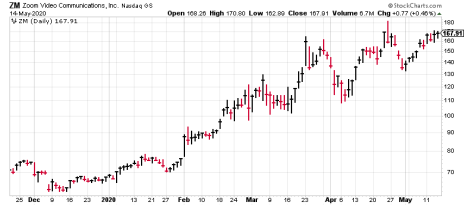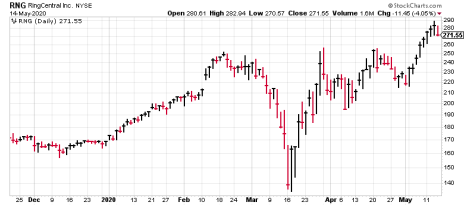Everybody in the U.S. seems to be using Zoom these days—not only for work but for birthday parties, cocktail parties, book groups, fitness classes and more, basically all the things we used to do together, face to face.
A basic Zoom meeting is free—and allows up to 100 participants—but is limited to 40 minutes. If you want more than that, you’ve got to pay—and increasing numbers of people are.
Zoom’s next quarterly report, which will give a look at the effect of the COVID-19 shut-in, won’t be released until June 2, but the previous report was terrific!
In the quarter ended January 31 (which was the fourth quarter of fiscal 2020), revenue was $188 million, up 78% from the year before, while EPS was $0.15 per share, up 275% from the year before. Seeing earnings growing faster than revenues is a good sign; it tells you the operation is getting more efficient while adding new customers. And that’s as it should be for a company whose value lies mainly in its cloud-based software.
[text_ad]
At the end of the year, Zoom had roughly 81,900 customers with more than 10 employees, up 61% from the year before, and 641 customers paying more than $100,000 in the previous 12 months, up 89% from the year before. So trends were very good before the pandemic and have undoubtedly gotten even better since.
And investors in Zoom Video (ZM) have rewarded the stock appropriately, boosting it from 60 last December to a recent high of 180.
A Better Stock?
However, there may be an even better stock, and its name is RingCentral (RNG).
RingCentral stock, of course, is not as famous as Zoom, but as we all know, fame may be fleeting; the hottest stocks often become the coldest stocks—and that’s a risk with Zoom. Will the stock stay strong as the economy slowly reopens?
One positive factor for Zoom is that the company’s goal is to make Zoom meetings better than in-person meetings. If they can succeed at that, the odds are good that people will keep using Zoom.
One big negative factor, however, is that right now Zoom is a one-trick pony, and if someone else comes along and offers a competitive product (especially if it’s someone like Amazon or Apple or Google, all of whom already have devices in our homes), Zoom’s fortunes could suffer.
So let’s take a look at RingCentral (RNG), starting with the chart.
Last December RNG was trading at 160. By February it had climbed to 250—and then the coronavirus market crash dragged it down to 140. But RNG quickly bounced right back up to 250, and the coolest part of this chart is that RNG has since broken out to new highs, in a run that included eight consecutive days of buying!
So what does RingCentral have that Zoom doesn’t?
For starters, in addition to video and voice, both of which Zoom enables, RingCentral “empowers employees to work better together, from any location, on any device, and via any mode to serve customers, improving business efficiency and customer satisfaction. The company provides unified voice, video meetings, team messaging, digital customer engagement, and integrated contact center solutions for enterprises.”
In short, that means video and voice plus email, texting and faxing, which means that fundamentally, RingCentral has a greater chance of becoming the main provider of a company’s communications software.
Like Zoom, all RingCentral’s software resides in the cloud, so it’s easily accessible globally.
And RingCentral has a fine growth record, though it’s not as fast as Zoom’s. In 2019, revenues were $903 million, up 34% from the year before, and EPS was $0.82, up 6%. Analysts are looking for 12% EPS growth in 2020 and 29% in 2021.
In the quarter ended March 31, revenue was $268 million, up 33% from the year before, and EPS was $0.19, up 12% per share. And management raised guidance, projecting annual growth of subscriptions revenues of 25%-26%, total revenue of $1.116 to $1.125 billion, and EPS of $0.91 to $0.94.
In fact, those projections are a major reason for the stock’s strength over the past two weeks.
Ring Central Stock vs. Zoom Stock
Zoom was founded in 2011 and came public just last year, while RingCentral was founded in 1999 and has been public since 2013, so RingCentral is a lot more mature, both as an operation and as a public company.
Both stocks have a market capitalization of roughly $21 billion, which means that ZM is more expensive than RingCentral stock — and that’s as it should be.
So which one do I like?
I like them both, actually, which is why both stocks are now in the portfolio of Cabot Stock of the Week. RingCentral stock has been there since October, and our profit is 80%, while Zoom has only been there since March, so our profit is “just” 50%.
But if you only want one? More aggressive investors should gravitate toward ZM, being careful to employ all the usual tools of risk reduction, while less aggressive investors will gravitate toward RNG.
[author_ad]



